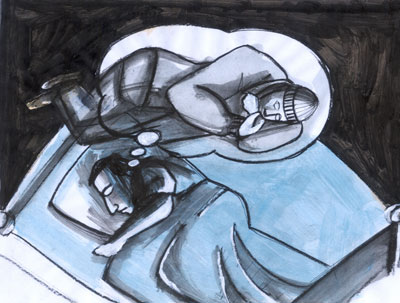 Every Saturday, we’ll be posting a new illustration by David Lester. The Mecca Normal guitarist is visually documenting people, places and events from his band’s 27-year run, with text by vocalist Jean Smith.
Every Saturday, we’ll be posting a new illustration by David Lester. The Mecca Normal guitarist is visually documenting people, places and events from his band’s 27-year run, with text by vocalist Jean Smith.
Having told Martin much more about the sailboat than she ordinarily would, she trimmed back on the part about Europe. Surprised that Martin had picked up on her desire to go to India without her directly saying so encouraged her to elaborate on some facet of the adventure that would resonate with him. Carpenter, artist. What else did she know about him? Most of the conversation had been about her. Not wanting to descend into a contrived politeness by asking him if he’d been to Europe, Nadine sensed that really, it was time to turn over his painting.
Without saying anything more about India, Europe, sailboats or rub rails, Martin walked across the room, picked up the painting and brought it back to Nadine.
“Better light over here,” he said and leaned it against the step ladder.
“Let’s put it on the wall,” Nadine said, pointing. In her peripheral sensibilities, the painting registered as smooth, shiny, blurry, dark. Martin picked it up and hung it on the wall. Arms spread, he held it by the sides; his body blocked most of it as he attended to straightening it, giving Nadine a moment to review the words gallery owners used to let an artist down gently, but when Martin stepped aside, that list, those words, sifted away from the forefront of her mind. The painting was a story being told under a turbulence of gold storm clouds, the beginning, middle and end were confidently represented in its composition, nearly equal parts of twilight sky, dense forest too dark to chime its annoyance of contrary greens and the sea, a foreshadowing groundwork siphoning off any residue of a conclusion. The tonal values were immaculate in their relationships to each other. The sky’s improbable orangey gold produced rancorous rumblings in the water’s complementary blue notes, but this wasn’t a landscape for the sake of placing the painter on an opposing shore, standing out there doing his painting thing. Seeing, interpreting, recording. This was a Thelonious Monk of a painting, before Monk was regarded as cataclysmic. This was the telling. Not the told.
Nadine took several steps toward the painting without intending to. She’d planned to use her distance from it to let Martin know what she anticipated having to tell him, but now, what she wanted was to further inspect the story, suspended, as it was, in its perpetual state of unending.
In a nod to the theatrical, a gesture of light emanated from a red triangle on what must have been the shoreline, a beach.
“It’s a tent,” Martin said. “One of the red tents they put up during the Olympics. For homeless people. To give visitors an impression of homelessness in Vancouver.”
“Wow,” Nadine said, bending toward it involuntarily to increase a sense of being enveloped by the purpose of the red, the tent, the warmth of the sentiment, which was deftly created by the cold heart of capitalism, the concept, the color and the composition. “It’s totally great.”






